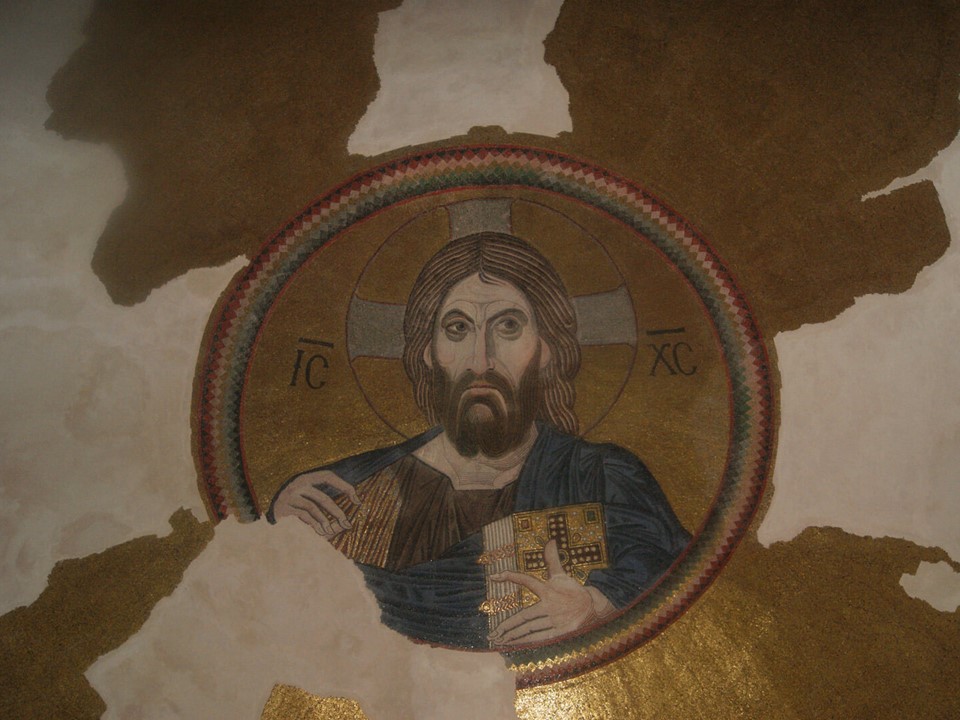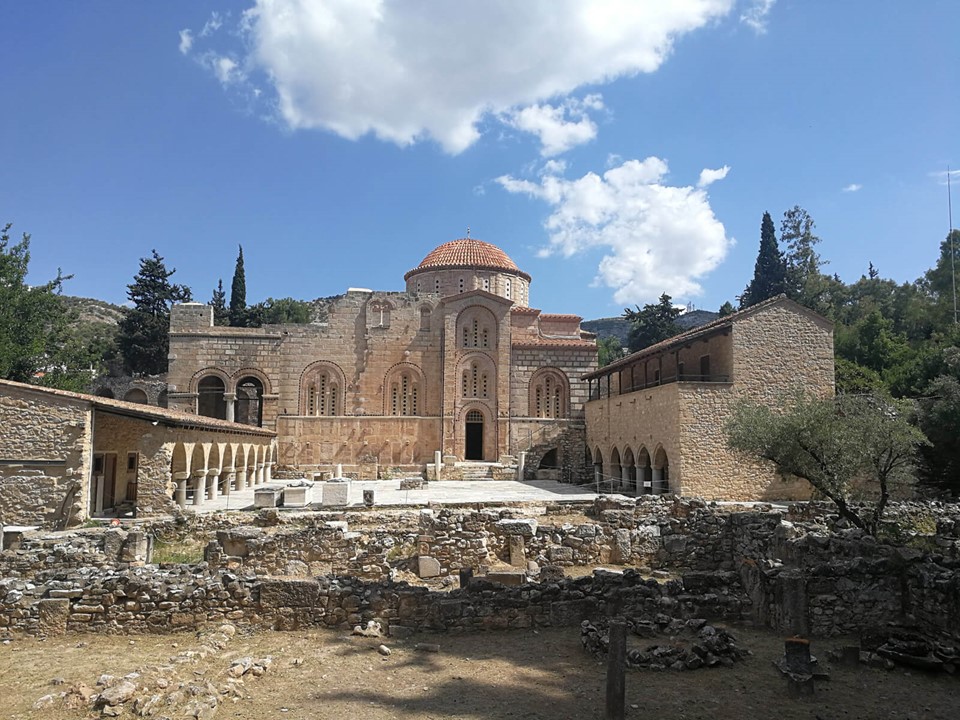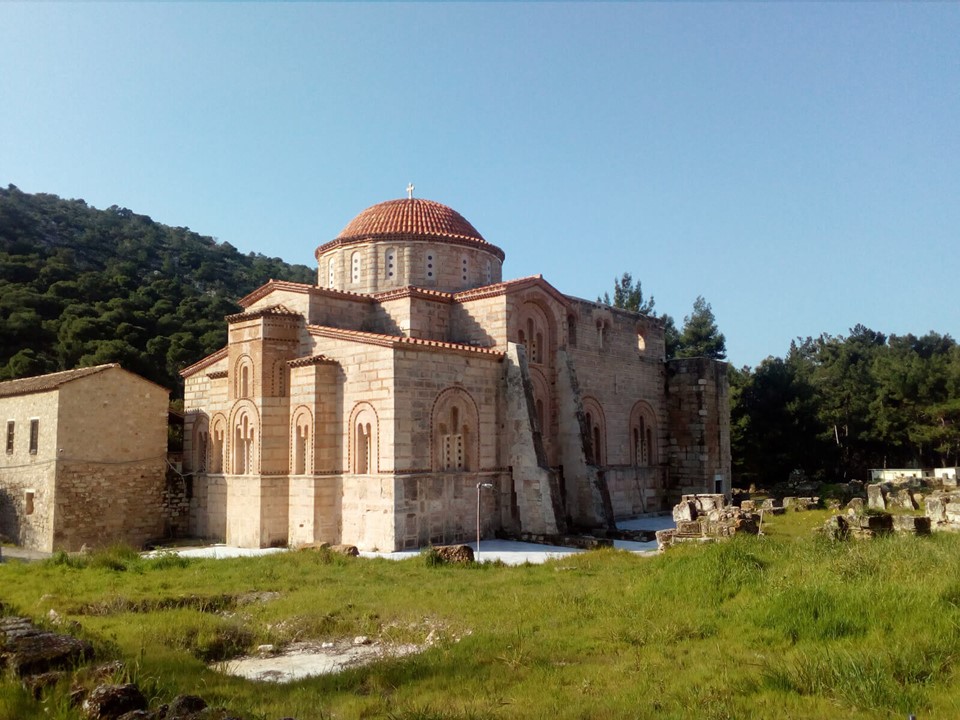
https://www.efada.gr/%CE%91%CF%81%CF%87%CE%B1%CE%B9%CE%BF%CE%BB%CE%BF%CE%B3%CE%B9%CE%BA%CE%BF%CE%AF-%CE%A7%CF%8E%CF%81%CE%BF%CE%B9-%CE%9C%CE%BD%CE%B7%CE%BC%CE%B5%CE%AF%CE%B1/%CE%9C%CE%BF%CE%BD%CE%AE-%CE%94%CE%B1%CF%86%CE%BD%CE%AF%CE%BF%CF%85
Christ Pantocrator in the Byzantine Monastery of Daphni… whose great eyes, dark and exorbitant and cast almost furtively over one shoulder, at total variance with His right hand’s serene gesture of blessing and admonition, spell not only pain but fear, anguish and guilt, as though He were in flight from an appalling doom. The only fit setting for such an expression is the Garden of ! Gethsemane; but this is a Christ-God in His glory, the All-Powerful One. It is tremendous, tragic, mysterious and shattering… writes Patrick Leigh Fermor in his travel book Mani. Travels in the Southern Peloponnese of 1958. https://patrickleighfermor.org/tag/mani/ and https://www.biblio.com/mani-by-fermor-patrick-leigh/work/20200
The sight of the Pantocrator image at Daphni is indeed breathtaking, and I particularly like Fermor’s use of adjectives… tremendous, tragic, mysterious, and shattering! Whether Fermor was right or not in his description… whether the Daphni Pantocrator survives today exactly as it was created by the anonymous 11th century Byzantine master… is not easy to answer, but was expertly addressed by Robin Cormack in his 2009 article Rediscovering the Christ Pantocrator at Daphni. Professor Cormack takes his reader on a wonderful journey as he “deciphers” the secrets of this amazing mosaic and the wondrous ways of mosaic restoration. Journal of the Warburg and Courtauld Institutes, Vol. 71 (2008), pp. 55-74 (20 pages) Published By: The University of Chicago Press https://www.jstor.org/stable/20462776?read-now=1&refreqid=excelsior%3Aefe48f19a158ab3c7526e9941fbf2d9f&seq=20

https://www.efada.gr/%CE%91%CF%81%CF%87%CE%B1%CE%B9%CE%BF%CE%BB%CE%BF%CE%B3%CE%B9%CE%BA%CE%BF%CE%AF-%CE%A7%CF%8E%CF%81%CE%BF%CE%B9-%CE%9C%CE%BD%CE%B7%CE%BC%CE%B5%CE%AF%CE%B1/%CE%9C%CE%BF%CE%BD%CE%AE-%CE%94%CE%B1%CF%86%CE%BD%CE%AF%CE%BF%CF%85
Visiting the Daphni Monastery has always been a wonderful experience! Built on the slopes of Mount Egaleo in the grove of Haidari, next to the ancient Athenian Ιερά Οδό (Sacred Road) that connected Athens with Eleusis, the site of the eponymous Eleusinian Mysteries, lies the Byzantine Monastery of Daphni. It is only interesting that the Monastery was built on the location of the ancient sanctuary of Apollo Daphnaios, destroyed during the invasion of the Goths in 395 AD. Unfortunately, of the old temple only one Ionic column still remains in the colonnade of the narthex, while the rest were removed by Lord Elgin in the 19th century. http://odysseus.culture.gr/h/2/eh251.jsp?obj_id=1514

https://www.efada.gr/%CE%91%CF%81%CF%87%CE%B1%CE%B9%CE%BF%CE%BB%CE%BF%CE%B3%CE%B9%CE%BA%CE%BF%CE%AF-%CE%A7%CF%8E%CF%81%CE%BF%CE%B9-%CE%9C%CE%BD%CE%B7%CE%BC%CE%B5%CE%AF%CE%B1/%CE%9C%CE%BF%CE%BD%CE%AE-%CE%94%CE%B1%CF%86%CE%BD%CE%AF%CE%BF%CF%85
According to the Greek Ministry of Culture (ΟΔΥΣΣΕΥΣ site), the first monastic community at Daphni was organized during the 6th century AD and was enclosed by strong defensive walls, almost square in plan. The catholicon was a three-aisled basilica which stood in the center of the courtyard. Along the inner NE side of the walls, two-storied buildings were constructed, containing the cells of the monks. A reception hall and a second block of cells were attached on the north wall of the enclosure. http://odysseus.culture.gr/h/2/eh251.jsp?obj_id=1514
What we see today is the 2nd phase of development and construction, dating from the 11th century (around 1080). The Monastery’s Katholikon is a cross-in-square church of the octagonal type, surmounted by a broad and high dome. It has a narthex, formed as an open portico… The exonarthex was constructed a little later, in the early 12th century and the chapel to the west was added in the 18th century… The porch with the three pointed arches in the west facade of the narthex was added in the 13th century by the Frankish monks and certainly points to western influence… The walls of the church are built in the simple cloisonne masonry with poor brick decoration, restricted on the windows… The monastery is protected by a square enclosure fortified with towers and ramparts, with two entrance gates on its east and west sides. http://odysseus.culture.gr/h/2/eh251.jsp?obj_id=1514
For a Student Activity, please… Check HERE!
For an interesting Video on the Daphni Monastery, please Check… https://www.archaeology.wiki/blog/video/daphni-monastery/